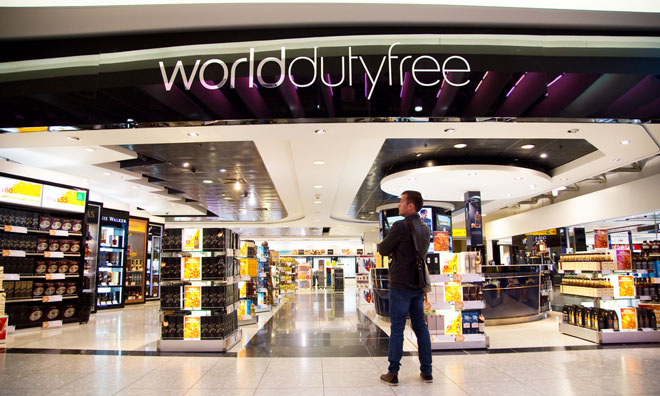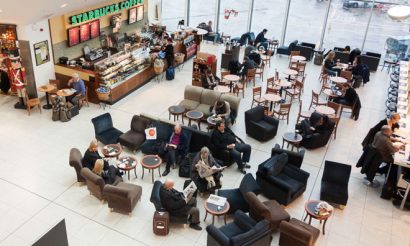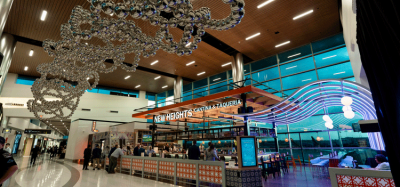Who really owns the passenger’s spare time?
- Like
- Digg
- Del
- Tumblr
- VKontakte
- Buffer
- Love This
- Odnoklassniki
- Meneame
- Blogger
- Amazon
- Yahoo Mail
- Gmail
- AOL
- Newsvine
- HackerNews
- Evernote
- MySpace
- Mail.ru
- Viadeo
- Line
- Comments
- Yummly
- SMS
- Viber
- Telegram
- Subscribe
- Skype
- Facebook Messenger
- Kakao
- LiveJournal
- Yammer
- Edgar
- Fintel
- Mix
- Instapaper
- Copy Link
Posted: 9 November 2016 | Mike Pearson | Director | Helios | 6 comments
Mike Pearson, Helios, describes how he has no intention of trawling through duty-free retail and the need for a rethink of passenger experience…


Helios, the aviation consultancy of Egis, focusing on air traffic management and airports, give their view on what the passenger really wants once airside in an airport…
We are told that, with the expansion of new travel-related technologies, comes more ‘free’ time during a passenger’s journey to, and through, the airport. However, the assumption is always that this time belongs to the airport, which can then woo, entertain and sell to passengers in a post-security nirvana. Airport concepts of the future are now being drawn as playgrounds, but just how real is this notion?
As both a user, and designer, of airports, I’m sorry to report that I’m that guy that walks on to the plane at the last minute: you know him, the one who is threatened with off-load for fear of missing the almost mythical on-time departure!
The reality, though, is that I’m not lost in the shops, or sipping champagne nor am I having a facial massage…simply put, I choose to NOT spend all of my pre-flight time at the airport! I’m clearly not alone, as more and more passengers choose to bypass the pre-flight shopping experience altogether in preference for smaller, dedicated, lounges where they can at least subtly exert some choice in how they use their time.
The assumption is always that this time belongs to the airport, which can then woo, entertain and sell to passengers in a post-security nirvana…


My thesis here is that airport designers and operators need to carefully reconsider future travel experience – and the distinct possibility of radically different scenarios for mass air travel – and how they design new and existing facilities and operations to cope. Our travel habits have changed due to new technologies, but have they changed in the way we originally anticipated? It is no longer sufficient for airports to pay lip-service to looming technological change, only to tweak the existing travel paradigm and then backfill it with a massive new dose of passenger indulgence.
I choose to NOT spend all of my pre-flight time at the airport!
I remain unpersuaded by the implicit assumption that just because I will have more time to spare means that my spare time, and money, will get spent at the airport. If reality is shifting into ‘immersive’ experiences using a Google VR cardboard box, then who is to say what we might be doing in advance of flights in the future? Maybe we’ll be doing shopping or security screening in totally new ways, using VR self-service processes that can be done anywhere and anytime before arrival at the aircraft door.
“Just because I will have more time to spare means that my spare time, and money, will get spent at the airport…”
“Just in time” delivery might no longer apply solely to car parts at Nissan’s factory, but might be the norm for passengers accessing their flight, having arrived seamlessly from home by an Uber-esque air-drone-taxi service.
Far-fetched? Maybe. Maybe not.
But the converging space of airport concept planning, airline business models, mass travel, new building engineering methods, all coupled with rapid technological advances and heightened environmental awareness, suggests that the existing paradigm might well be in need of a fundamental overhaul…
Biography
Mike is Sales & Marketing director at Helios and has spent much of his career advising on major airport developments around the world. For London, he has been leading the Mayor’s assessment of a new hub airport and he previously led the programme management for Heathrow’s third runway expansion plans. His thought leadership is recognised in the industry where he has been contributing to other major hub developments, including advising on Dubai’s future transition. He previously led the UK Government’s airport capacity assessment for the 2012 Olympics, was Technical Director for Gatwick’s major midfield pier development and has developed competition-winning masterplans for Medina and Qingdao airports.



















As long as the public worries about the time it will take to get through security and as long as airports need to generate revenue away from airline fees and federal subsidies, the airport will “own” the travelers’ free time.
Ultimately, it is the individual air traveler that controls their own destiny once they enter the sterile area of the terminal post-security. Most of us who either have worked in airports or have studied air passenger behavior in airports have discovered different types of travelers, each with their own goals and objectives when traveling. Frequent business travelers want very little except to quickly go through their dedicated queue into the security checkpoint…and then out to the gate where they receive expedited boarding into the aircraft and their business class seat with all of the amenities (assuming they have chosen to utilize the airline’s club lounge). Those who travel for pleasure are more likely to be swayed by the airport’s amenities including food offerings and retail entertainment…as the airport is just as much a part of the vacation experience as the travel itself to their holiday destination.
Beware of the paradigms that accompany these responses. The premise of the article is that all the landside / transition to airside activities will occur elsewhere – i.e. “off-airport”. This in turn changes the definition of the “airport” to something which more closely resembles the definition of an “airfield” (i.e. a place dedicated to aircraft). “On airport” passenger accommodation evolves into a facility resembling today’s airside terminal satellite.
I agree with the author. Beware of building excessive meg-airport terminal facilities which may, in the future, no longer be required. So how do we convince designers and airport operators to evolve airport passenger facilitation from where we are today to the “Airport of the Future”?
The article provides a number of considerations for airport operators and terminal planners. On one hand, I agree with the point that airports can’t continue to pay “lip service” to the customers who frequent their facilities, however, I believe this point is beginning to change and those airports that are recognizing this are leading the pack in regard to the customer experience. If you look at Changi and Inchon as examples, you will find they are catering to a broad spectrum of travelers and successfully doing so.
One point I believe was not effectively addressed is the hub airport concept where the majority of the passengers are connecting through vs. the O&D passengers who will often wait to the last minute to arrive at the airport and will spend a majority of the time on security/Immigration lines then go to their respective departure gates. Yes, the connecting passenger will oftentimes seek a quiet place to relax between flights, but generally its the frequent traveler and the business/1st class passenger who will seek out a membership lounge. The less frequent and economy passenger will seek out shops and food/beverage options to satisfy needs and kill time. For example, its these passengers who Heathrow caters to where it waits to the last minute to post a departure gate. In the meantime, the passengers are left to wander the shops and restaurants and spend their Euro/Pound/dollar until their gate # is posted.
I do believe though as airports undertake construction of new facilities and/or redevelopment of existing ones, they need to be as flexible as ever. For example, security is an ever changing dynamic that requires facilities to adapt to the new technology which usually lags behind the threat. The equipment that was used at airports only 10 years ago, is obsolete today and checkpoints have had to be modified to accommodate the newer models. This is nothing new though. If you look back even further to 20 years ago, the protocols for screening of passengers was different. There were no trace detection units and Full Body Imaging was a sci-fi dream. Them same goes for baggage systems where bags are screened in-line.
Mike Pearson is on target with his thoughts that airports need to recognize the existing paradigm might well be in need of a fundamental overhaul, but in order to make the overhaul, its important to realize the changes will need to continuously be assessed and updated.
Airports for so long followed the path that passengers arrived at the airport to board or de-board an aircraft. Then over the past 40-50 years, the idea that airports could make money and satisfy the passengers by offering retail, food and beverage was the established mantra and the way to standout as a best-in-class facility. Today and for the foreseeable future, it would appear that additional services need to be offered to achieve that best-in-class distinction. In 10-20 years though, who knows what the passengers will be seeking and what the requirements will be for security.
Finally, in speaking to Mike’s point, airports need to be flexible, open to new ideas, hire people who think outside the box and be ready to make changes on a more frequent basis to meet the ever changing industry demands and not accept the status quo.
I was late to the gate in EK’s Terminal3 and missed my scheduled flight (while shopping in Duty Free). I had to wait about 5 hours for the next flight.
I did many things:
– With remaining 3G credit in my mobile, I spent time communicating to family and business.
– I spend more than an hour in the prayer room catching two prayer times (out of five daily muslim prayers, reading in between them)
– It attracted me there are shower cabins. It is good to get cleaner and meet family fresher.
However, given we have to be early in airports and waste time there:
– Free Wifi must be available and working in every airport
– Coffeeshops and small restaurants should serve feasible food and drink. Passenger should not pay for the excessive rate of rent.
Depending on the type of airports some % of passengers are shopping, using restaurants, lounges or consuming otherwise. Great. Have an attractive airport, means to simply cover a passenger right. To choose to do whatever you like. That’s all. You choose to straight go to the air-seat. You belong to the, maybe 5% who do that. Others go to the lounge, they belong to the other x% and so no… But to think we go back to the terminals where you get free filtered water and a newspaper and nothing else, would be a bit naive. Cheers